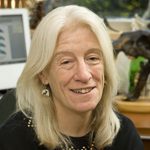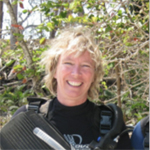Brenda Larison

I am fascinated by the myriad of physical forms and behaviors that animals display. In my research My research uses genomic tools to understanding both how this amazing diversity evolves and how to conserve it. Currently most of my work is on zebras. In collaboration with colleagues at UCLA, other institutions in the US and abroad, I utilize the extensive variation in stripe pattern in zebras in an effort to understand the function of stripes and to pinpoint the genetic and developmental mechanisms that create stripe patterns. In more conservation focused work, we have examined the impact of habitat fragmentation on population structure and inbreeding and the potential consequences of inbreeding for the stripe phenotype. In addition, we have recently developed an epigenetic clock based on plains zebras, with which we successfully aged other equids, including two endangered species. The ability to accurately age wild animals is essential to predicting population viability.
Blaire Van Valkenburgh

I am a paleontologist interested in deducing the ecology and behavior of extinct animals. For example, how can we determine if extinct species were social? At Rancho La Brea (the famous tar pits in Los Angeles), large Pleistocene carnivores were lured to their death by the sounds and smells of herbivores trapped in sticky asphalt. Studies of living African carnivores reveal that social species, such as lions, hyenas, and jackals, are much more likely to come to the sounds of dying antelope than solitary species such as leopards and cheetahs. Apparently, it is better to arrive at a carcass in a group of others in case you have to fight for possession. At La Brea, the dominant carnivore species were dire wolves, sabertooth cats, and coyotes. Like modern lions, the sabertooths even brought their cubs occasionally. Based on the African studies, these findings strongly suggest that all three of these species were social, and provides some of the best evidence for sociality in a sabertooth cat thus far.
Victoria Sork

I study how tree populations exist and persist. To do this, I integrate theories and methods from ecology, evolutionary biology, and population genetics. Because genetic diversity is a key ingredient to the ability of populations to respond to environmental change, one element of my research explores how genes move within and among landscapes through pollen dispersal. In addition, I am curious about how seeds move because seed dispersal is key to the regeneration of populations. Both pollen and seeds can be dispersed by animals, which mean that we must understand how birds and bees and bats and other mammals (to name a few) move pollen and seeds. If animal pollinators and seed dispersal agents disappear, many tree species are jeopardized. I often say that my research goes from the DNA sequence to the landscape because I use genetic tools to understand the landscape processes. Our research group conducts studies in Central America, Mexico, Africa, South America, North America, and especially California. In California, I am studying the impact of landscape change on oak populations and using this information to develop priorities for conservation that will enhance the long-term survival of oaks in the face of climate change. By studying tree species, I am always focusing on the plants that define the ecosystem. Thus, my research generates information on the ecological and evolutionary concepts that shape natural populations, and provides criteria to manage their long term survival.
Tom Smith

I am interested in improving the scientific basis for conservation programs to preserve biological diversity. Many approaches in conservation are not sufficiently evidence- and science-based, often relying on personal experience or conventional wisdom with little or no connection to theoretical or empirical work on the evolutionary ecology of the organisms to be conserved. For example, many criteria for prioritizing regions for conservation are based on relatively simple indices such as the number of species in the area or degree of perceived threat, so-called “hotspot” approaches. These approaches often fail to capture essential evolutionary and ecological processes that promote and sustain biodiversity over time. Moreover, the hotspot approaches are static and do not acknowledge the tremendous challenge that global climate change poses for predicting where species will need to relocate, and how quickly. My group is engaged in a relatively new field called “niche modeling,” which takes data on the ecology of organisms targeted for conservation efforts, defines the biotic and climatic envelopes characterizing their current geographic distribution, and then projects the likely changes in species ranges under various climate change scenarios. If these are done for a multitude of species with overlapping requirement a picture emerges of what to expect for entire communities of plants and animals. This is particularly important but difficult in the tropics, which are expected to face novel climates in this century that they have not experienced in at least the last 10 million years. We have developed niche modeling methods that we hope will allow conservation decision makers to map not just the patterns of biodiversity, but also the processes that will produce and sustain it under changing climate regimes predicted for the near future.
Barney Schlinger

I am interested in the proximate mechanisms controlling animal behavior, particularly in how hormones are involved. You might have thought that hormones are always slow-acting, but this is not true. For example, we have, for the first time, measured rapid changes in the amounts of the sex-steroid estradiol in the auditory system of birds as they interact with other birds or hear the sounds of other birds. Our study species is the zebra finch, a model species for most laboratory studies of birds because they are very easy to maintain in the lab. Rapid synthesis of estrogen occurs in the brains of zebra finches, and the estrogen quickly increases the strength of nervous system responses to songs of other zebra finches. We have discovered that estradiol functions almost like a rapid-acting neurotransmitter, modulating core functions such as song learning and song expression in birds. Similar changes appear to occur in the hippocampus of scrub jays as they form and retrieve memories of sites where they store food. Birds are exceptional model organisms for understanding hormones and complex cognitive behaviors.
Lawren Sack

I am a plant ecologist interested in the great diversity of morphological and physiological features and functions that plants have evolved to live in their environments. One of the critical physiological functions of plants is the regulation of their water use. There are enormous differences among plants and among entire plant communities such as forests in how efficiently they use water. These differences in turn have practical implications for the retention and supply of clean water by different forest ecosystems. We recently discovered that in Hawaiian timber plantations, alien tree species that were introduced into Hawaii can use more than twice the amount of water to grow as native forests. This finding indicated that preserving native tropical forest has value beyond the conservation of the native trees, because water is expensive. Consequently, land management decisions can place ecosystems-and the people who depend on them-at increased risk of water shortages. We are conducting further research to understand why plants use different amounts of water that should eventually allow construction of water budgets over entire landscapes with complex land use mosaics, and from small-scale gardens to forests to large parks. In other projects, we are investigating the adaptation of plants to their environment, with a special focus on the evolution of plant groups that include endangered species. While our research is centered on pure science and discovery, this work has major environmental and economic implications, including applications toward the conservation of rare species and native forests.
Glen MacDonald

I am a geographer and paleoclimatologist interested in the lessons of the past for understanding our present-day climate change predicament, especially here in the North American Southwest. This region has experienced arid conditions since the start of the 21st century. In Southern California this has resulted in “Perfect Drought” conditions, with negative impacts on local water resources, supplies from northern California, and water from the Colorado basin. Allocations from the Colorado River were based on optimistic estimates in the 1930s of long-term average discharge. This over-allocation underscores the problems with relying upon short temporal data sets to set long-term resource policy. An important question is whether the Southwest is experiencing a temporary drought or a transition to a longer-term, more arid climate. One great unknown is how the Pacific Ocean and the El Nino – Southern Oscillation (ENSO) system will respond to increasing global temperatures. Empirical data from the 20th century and climate model predictions are inconsistent. I have been approaching this question by examining how previous prolonged episodes of climate warming have impacted the ocean and the hydroclimatology of the Southwest. Past warming periods include the Medieval Warm Period (~800-1300 AD) an Holocene Thermal Maximum (~8000 to 3000 years ago). Climate and ocean measurements are not available from these periods, but we can use natural records such as tree-ring chronologies and fossil diatom assemblages from lake sediments to provide proxy-based records of past hydrology and past ocean temperatures. Although such reconstructions are imperfect, the consistency of resu among different methods indicates that the eastern eastern Pacific has typically cooled during past warm periods and California has been particularly prone to increased aridity.
James Lloyd-Smith

I am interested in the ecology and evolution of infectious diseases, and I build mathematical models of disease spread and test them against epidemiological data to better understand disease dynamics. From HIV to pandemic influenza, most infectious diseases of humans originate in other animal species, and many (like rabies or West Nile virus) cross the animal-human boundary all the time. These shared animal-human pathogens, known as zoonoses, impose heavy health burdens worldwide and are difficult to study and control because of their complex ecology. For example, they often have multiple host species interwoven with complex environmental influences. Mathematical models are a vital tool to tackle this complexity. In a recent study I led a team of scientists in an effort to identify shared patterns among zoonotic infections and set priorities for future research. We found that models have helped build basic understanding and health policy for infections like SARS, pandemic flu, and “mad cow” disease. However, we also found that research efforts have been heavily skewed to these particular diseases, and that little or no work has been done on many other globally significant diseases. There are also important gaps in modeling of crucial processes such as animal-to-human disease transmiss and the rapid evolution of pathogens once they’re circulating among humans. We have proposed steps for the research community to address these shortcomings and propel the global fight against zoonoses – and I am pursuing these aims in my lab at UCLA, where I work on zoonose such as SARS, human monkeypox and leptospirosis.
David Jacobs
My research combines paleontological studies and geology with molecular approaches to understand the early evolution of animal life. We are pursuing this work as part of the Advent of Complex Life -NASA Astrobiology group, combining studies of the geologic and geochemical context of this early evolution with studies of the phylogeny, genomics and metabolic processes of relevant modern organisms. My student David Gold and I were just in Newfoundland looking at the wonderfully preserved enigmatic Ediacaran fauna that precede the Cambrian Radiation, the rapid appearance of most animal body plans a little over 500 million years ago. In our lab we use molecular approaches to examine the development and evolution of sensory and neural organization of early branching animals such as jellyfish to better understand this early evolution of animal complexity. Another research theme in my lab explores the differentiation and speciation of marine organisms along the west coast in the context of their geologic history. Our work shows that the fauna of the California coast-perhaps the most diverse temperate coastal marine fauna in the world-is a relict of a burst of speciation that took place 12 to 5 million years ago when upwelling of nutrient rich waters and biotic productivity was far higher than today. Our work has conservation implications. Understanding the processes that form coastal habitats such as estuaries, and the ecology of the many endangered species that evolved and live in them, is essential for making informed management decision as we confront the dual challenges of development and climate change along the California and Gulf of California coastlines.
Greg Grether

As a student of animal behavior, I am curious why some species are aggressive to other species, and I want to understand the evolutionary consequences of such aggression. The Nobel Prize winning ethologist, Konrad Lorenz, suggested in 1962 that interspecific aggression might help explain the spectacularly diverse coloration of coral reef fishes. Lorenz’s aggression-based mechanism for generating species differences has always been overshadowed by Brown and Wilson’s (1956) reproductive character displacement hypothesis, which says that species evolve divergent color patterns for species recognition to avoid mating with the wrong species. Previous attempts to test these two hypotheses have not cleanly separated the predictions, which predict the same geographic patterns in signals (less overlap in signals when species occur together than when they are geographically separated). We got around this problem by directly testing for shifts in what animals recognize as competitors. Our study animals are damselflies (related to dragonflies, but damselflies can fold their wings over their back when resting, and dragonflies cannot). We discovered that territorial male damselflies pay attention to species differences in wing coloration to tell intruders of their own species apart from intruders of other species, but only in places where the two species naturally occur together. Our experiment is one of the clearest demonstrations yet of an evolutionary process that is probably very common in nature but which has largely been overlooked.
Peggy Fong

Caulerpa is a common tropical green large alga (macroalga) that has been dubbed the killer alga by the media, not because it kills humans, but because of massive blooms of this species that blanket and smother coral, killing whole sections of reefs. But how does Caulerpa persist between blooms, when it can become rare? We became interested in the question of how patches of Caulerpa are maintained in low abundance in the eastern Pacific but then can episodically bloom and spread over entire reefs. We discovered that blooms only happen when a combination of factors is just so. These factors involve interactions between herbivores, nutrients. and another alga that grows on Caulerpa and acts as a defense against herbivores. Together, they can create the perfect storm of interactions, triggering harmful blooms. The lesson of our study is that to understand and be able to predict the complex behavior of coral reef communities, it may be necessary to consider more than a single potential causal factor, but rather, the interaction of several factors, some of which might be quite unexpected. Our new understanding of the complex set of interactions leading to bloom events will contribute to the protection and conservation of coral reef habitats around the world.
Paul Barber

I am interested in phylogeography-putting the evolutionary tree of life (phylogeny) into a geographic context. I am decoding (from sequencing the DNA of genes) the history of the origination and dispersal of marine organisms, particularly among the complex archipelagoes of the Indopacific. I study both invertebrates and vertebrates (e.g., fish). The story of the giant clam is an interesting example. It bores into tropical coral reefs and can’t move as an adult. However, the larval stages are planktonic and drift passively on ocean currents. One might think that these currents would mix the larvae of giant clams everywhere, but our genetic studies show that this hypothesis is not true; many populations of giant clams are very isolated. One indication of isolation, we discovered, is that these populations have evolved their own unique communities of symbiotic algae in response to different water temperatures. There are several potential practical benefits of our research. The genetic structure of giant clam populations provides useful data for planning networks of marine reserves for thes threatened ecosystems. Also corals and giant clams share the same algal species (from which clams and corals derive sugars and other vital substances). Corals lose these algae when sea temperatures rise, so-called coral bleaching, but clams do not. Thus, clams may provide a local reservoir of algae to help corals recover following bleaching episodes.
Mike Alfaro

I am interested in understanding why different groups of vertebrates-animals with backbones-
have very unequal diversity-vastly different numbers of species. For example, there are about
10,000 bird species but only 23 crocodilians. This is an old question, but it is very exciting that
with modern tools allowing us to sequence the base pairs in the DNA of individual genes, we can
get some answers. These DNA sequences evolve, changing at a slow steady rate, so we can use
the cumulative change as a molecular “clock” to estimate the age of different vertebrate groups.
With these tools we tested the hypothesis that groups having the most species today were just the
ones that have been around the longest and have had the most time to diversify. We recently
showed that this hypothesis is false. The evolutionary history of the vertebrates is dominated by
the explosive diversification of relatively young groups, including some (but not all) subgroups of
mammals, birds, and fish. Many classical explanations for species richness don’t hold up. For
example, one hypothesis is that bird diversity is linked to the evolution of flight or feathers.
However, we found that the real increase in the rate of bird diversification happened long after
these traits evolved. It is a very exciting time to be in evolutionary biology because at last we can
answer many of our most profound questions about the history of life on earth-questions that
seemed intractable just a few years ago.
Dan Blumstein

I am fascinated by animal behavior, and I have been studying behavior in a population of yellow- bellied marmots at Rocky Mountain Biological Station for many years. One long-standing question we have been attempting to answer in marmots is: how is the size of marmot groups regulated? These are social animals that live in extended family groups, but not all the kids can remain at home. There aren’t enough resources and presumably there is value in dispersing to avoid inbreeding. But not all the kids leave home; generally the sons disperse, but not all of the daughters. Recently, my students and I asked, what is different about daughters that leave versus those that stay home? We tested the “social cohesion hypothesis,” which says basically that “animals that play together stay together.” Remarkably, this idea has never been properly tested in the 30 years since it was proposed. We found that daughters that stayed home had more social interactions with more of their extended family members than did daughters that dispersed. Interestingly, it did not matter much whether the interactions were positive or negative, so long as there were more of them. We don’t yet know the reasons why females differ in their social interactivity. This question is interesting in relation to offspring dispersal in traditional human societies. Typically it is daughters that disperse more than sons, but it would be interesting to know whether there is variation among offspring that disperse or stay at home in terms of how socially interactive they are with their extended families.
